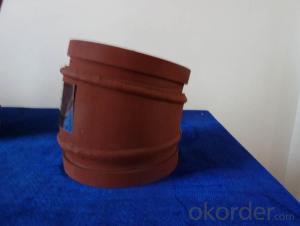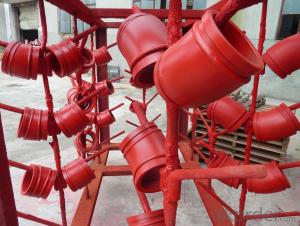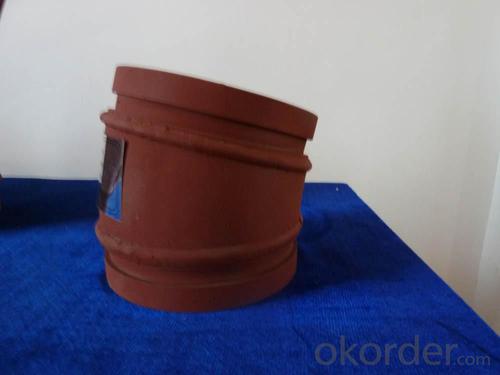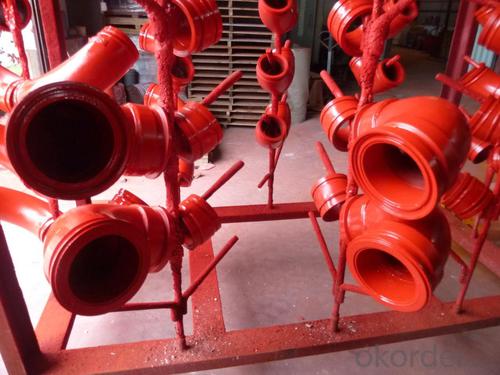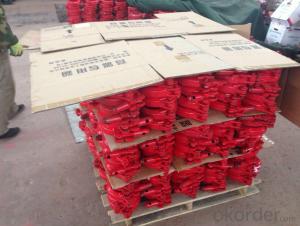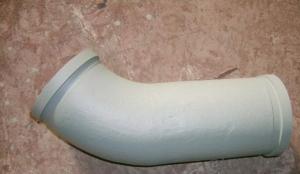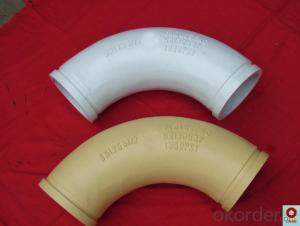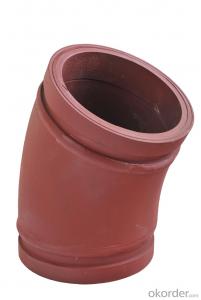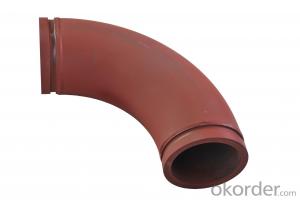Twin Wall Elbow for Concrete Pump R275 15DGR
- Loading Port:
- Tianjin
- Payment Terms:
- TT OR LC
- Min Order Qty:
- 30 pc
- Supply Capability:
- 5000 pc/month
OKorder Service Pledge
OKorder Financial Service
You Might Also Like
Twin Wall Elbow (Twin Wall Flange)
(1) Material: Q235 (outside) + GCr15(inside)
(2) Thickness: 3mm (outside) + 9mm (inside)
(3) Technology: Quenching under high temperature
(4) Characteristics: the inner rigidity to 63 HRC; the outside has so high toughness to keep the inner.
(5) Matched with: Twin wall flange, Alloy (GCr15) + 20#
(6) Working Pressure:170bar
(7) Service life: above 60,000 cubic meters.
(8) Package: PP woven bag and plastic cap
Twin wall elbow is created with research of us and need of the market. Its service life and working pressure are better than the casting. Besides, We can supply 90D, 45D, 30D, 25D, 20D, 15D, 10D. And it can be used for PM, JUNJIN, Schwing, Cifa, Sany, ect.
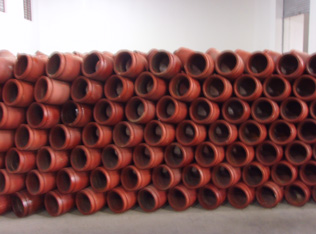

- Q: What is the function of a concrete pump outrigger?
- The function of a concrete pump outrigger is to provide stability and support to the concrete pump while it is in operation. The outrigger extends from the sides of the pump and is used to distribute the weight of the pump and concrete being pumped, preventing it from tipping over or causing any instability.
- Q: What are the potential risks of using non-standard or modified hydraulic components in concrete pump spare parts?
- Using non-standard or modified hydraulic components in concrete pump spare parts can pose several potential risks. Firstly, non-standard components may not have undergone the same rigorous testing and quality control as the original equipment manufacturer (OEM) parts. This means that their performance and durability may be compromised, leading to potential failures or malfunctions. Such failures can result in accidents, injuries, or damage to the equipment or surrounding structures. Secondly, using non-standard or modified components may void the warranty of the concrete pump and its spare parts. Manufacturers typically offer warranties to ensure the reliability and safety of their products. By using non-standard components, the warranty may become null and void, leaving the user responsible for any repairs or replacements needed due to issues arising from these non-standard parts. Another risk is the potential compatibility issues that may arise when using non-standard or modified components. Hydraulic systems rely on precise engineering and compatibility between various components to function optimally. Non-standard or modified parts may not fit properly or may have different specifications, leading to leaks, pressure imbalances, or reduced overall performance. Furthermore, the use of non-standard or modified components may also impact the overall efficiency and productivity of the concrete pump. OEM parts are designed to work seamlessly with the rest of the system, ensuring smooth operation and maximum output. By using non-standard parts, the performance of the pump may be compromised, resulting in increased downtime, decreased productivity, and higher maintenance costs. Lastly, the use of non-standard or modified components may also have legal and regulatory implications. In some jurisdictions, there may be regulations or standards in place that require the use of OEM or certified parts for certain equipment, including concrete pumps. Failure to comply with these regulations can result in fines, penalties, or legal liabilities in case of accidents or failures. In conclusion, the potential risks of using non-standard or modified hydraulic components in concrete pump spare parts include compromised performance and durability, warranty voidance, compatibility issues, reduced efficiency, and legal and regulatory implications. It is always advisable to use OEM or certified spare parts to ensure the safety, reliability, and optimal performance of the equipment.
- Q: What is the function of a concrete pump hopper grate pin?
- The purpose of a pin on a concrete pump hopper grate is to keep the grate securely in place and prevent it from moving or coming loose while concrete is being pumped. The pin acts as a locking mechanism, ensuring that the grate stays stable and does not pose any dangers or interrupt the pumping process. Furthermore, the pin allows for simple removal and replacement of the grate when needed, making it easier to maintain and clean the hopper. In conclusion, the concrete pump hopper grate pin is vital for preserving the reliability and effectiveness of the concrete pumping equipment.
- Q: What are the signs of a damaged concrete pump cylinder?
- Indicators of a damaged concrete pump cylinder are plentiful. One unmistakable sign is the leakage of hydraulic fluid from the cylinder. Should you observe any fluid dripping or pooling around the cylinder, it is possible that the seal or piston has been compromised. Unusual noises during operation can also suggest a damaged cylinder. If you detect any atypical clanking, grinding, or knocking sounds emanating from the pump, it may be a consequence of a damaged cylinder. This can stem from various issues, including a bent piston rod, worn-out bearings, or misalignment of components. A decrease in pumping efficiency is another common indication of a damaged cylinder. If you perceive that the pump is not effectively delivering concrete as it once did, it is likely due to a damaged cylinder. This can lead to diminished output, slower pumping speed, or even a complete failure to pump concrete. Performing a visual inspection can aid in identifying signs of a damaged cylinder. Observe the cylinder body for visible cracks, dents, or deformations. Additionally, examine the piston or piston rod for signs of excessive wear, such as scratches or grooves. Lastly, frequent breakdowns or malfunctions with the concrete pump can be an indication of a damaged cylinder. Consistent repairs or failures may be a consequence of underlying issues with the cylinder, such as fatigue, corrosion, or improper maintenance. Should you notice any of these signs, it is crucial to promptly address the issue. Continuing to operate a concrete pump with a damaged cylinder can result in further damage, increased repair costs, and potential safety hazards. It is recommended to consult a professional technician or the manufacturer to assess and repair the damaged cylinder.
- Q: How much is the pump for a month?
- Depends on you are a big pump, small pump, and now about 0.7 of the fuel consumption, and you do a month how much work, generally, if you do 10000 square a month, then two years to recover costs
- Q: What are the different types of concrete pump hydraulic filters?
- Construction projects commonly utilize various types of concrete pump hydraulic filters. These filters are crucial for ensuring the hydraulic system's smooth operation and longevity. 1. Suction filters, located at the hydraulic pump's intake side, play a vital role in removing larger particles and debris from the hydraulic oil. They prevent contaminants from entering the pump and causing harm to its components. 2. Positioned on the return line, return line filters are designed to eliminate smaller particles and contaminants from the hydraulic oil before it is returned to the reservoir. By maintaining oil cleanliness, they prevent system wear and tear. 3. Pressure line filters, typically installed after the hydraulic pump on the high-pressure side, remove fine particles and contaminants from the oil. Their purpose is to guarantee the valves, cylinders, and other hydraulic components work smoothly. 4. In-tank filters are submerged in the hydraulic oil reservoir to filter the oil as it circulates through the tank. They effectively eliminate larger particles and contaminants settled at the bottom of the reservoir. 5. Magnetic filters attract and remove metallic particles, such as iron filings and metal shavings, from the hydraulic oil. They are highly effective in capturing ferrous contaminants. 6. Breather filters, installed on the breather vent of the hydraulic oil reservoir, maintain the cleanliness and integrity of the hydraulic oil by preventing dust, dirt, and moisture from entering the system. Regular inspection and replacement of these hydraulic filters are crucial for optimal performance and longevity of the concrete pump's hydraulic system. Neglecting this maintenance can lead to increased wear and tear, decreased efficiency, and potential damage to the pump and its components.
- Q: How often should hydraulic filters be replaced in a concrete pump?
- Hydraulic filters in a concrete pump should be replaced on a regular basis to ensure optimal performance and longevity of the equipment. The exact frequency of replacement will depend on various factors such as the specific model of the concrete pump, the operating conditions, and the quality of hydraulic fluid used. As a general guideline, it is recommended to replace hydraulic filters in a concrete pump every 500 to 1,000 operating hours or at least once a year, whichever comes first. However, it is essential to refer to the manufacturer's recommendations and guidelines for the specific model of the concrete pump, as they may have specific maintenance schedules and intervals. Regular inspection of the hydraulic filters is also crucial to determine if replacement is necessary sooner than the recommended interval. If the filters are clogged, damaged, or show signs of excessive wear, they should be replaced immediately to prevent any potential damage to the hydraulic system. Additionally, if the concrete pump is operating in harsh or dusty environments, the filters may need to be replaced more frequently to ensure proper filtration and prevent contamination. Overall, proper and timely replacement of hydraulic filters in a concrete pump is essential to maintain the efficiency and reliability of the equipment, prevent potential breakdowns, and extend its service life.
- Q: How can a malfunctioning control box affect the pump's operation?
- The operation of a pump can be negatively affected by a control box that malfunctions. Initially, it can lead to an imprecise or inconsistent control of the pump's functions. This implies that the pump may not initiate or halt at the desired moments or operate at the correct velocity, resulting in ineffective or insufficient pumping. Furthermore, a control box that malfunctions can cause electrical problems, resulting in power fluctuations or even power surges. These electrical complications can harm the pump's motor or other components, leading to premature deterioration or complete malfunction. Moreover, a malfunctioning control box can also disrupt the communication between the pump and other systems. This can impact the pump's capacity to receive or transmit signals, resulting in a lack of synchronization with other equipment or systems that depend on the pump's operation. This lack of synchronization can result in system failures or interruptions in the overall process or operation that the pump supports. In conclusion, a malfunctioning control box can have adverse effects on the operation of a pump including imprecise control, electrical problems, and disruption of communication with other systems. It is essential to regularly inspect and maintain control boxes to prevent these malfunctions and ensure the reliable and efficient operation of pumps.
- Q: Is the main pump of the concrete pump electric control or hydraulic control?
- The main pump behind the oil pump to provide the size of the oil with the greater the current the higher the higher the higher the displacement,
- Q: How often should hydraulic pumps be inspected or replaced in a concrete pump?
- Hydraulic pumps in a concrete pump should be inspected regularly, ideally every 500 hours of operation or at least once a year. However, the frequency of replacement depends on various factors such as the quality of the pump, maintenance practices, and the intensity of use. It is crucial to monitor the pump's performance, fluid levels, and any signs of wear or damage to determine if replacement is necessary.
Send your message to us
Twin Wall Elbow for Concrete Pump R275 15DGR
- Loading Port:
- Tianjin
- Payment Terms:
- TT OR LC
- Min Order Qty:
- 30 pc
- Supply Capability:
- 5000 pc/month
OKorder Service Pledge
OKorder Financial Service
Similar products
Hot products
Hot Searches
Related keywords
